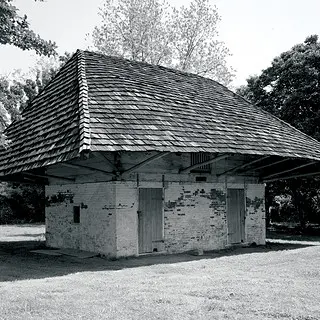
African American Cultural Heritage Action Fund
African House at Melrose Plantation
African House is located on the grounds of Melrose Plantation about 15 miles from Natchitoches, Louisiana, and is part of the Cane River National Heritage Area. Melrose Plantation is a National Historic Landmark and is considered one of the finest examples of a Creole plantation in America.
The plantation was established in 1796 by Louis Metoyer, a slave who would become a gens de coleur libre (free person of color) when his father granted his freedom in 1802.
By the 1820s, the plantation was prospering, and Metoyer had the African House constructed by his slaves. Although its original purpose is unknown, the building has seen service as a store house, residence for visiting artists, and as the home of the Clementine Hunter murals.
A 1973 report notes: “The African House is truly an enigma. No records remain which authoritatively date its construction, no records remain which identify its function. No evidence exists which explains how such a uniquely African structure came to exist in central Louisiana. But here it stands, with its bottom floor of massive slave-made bricks, its second floor of heavy, hand-hewn timbers, mortised and dovetailed together without the use of nails, and its fascinating hip roof of cypress shingles that supports a 12-foot overhang."



photo by: Library of Congress
Clementine Hunter’s murals depict early 20th century plantation life.
The history of Melrose Plantation and the African House is the multi-faceted cultural identity of the Cane River area and the story of the many ways this unique culture has been preserved. Groups represented by African House’s history include the Cane River Creoles, African-Americans, Caucasian-Americans, women, and artists.
African House’s hip-roofed building recalls the architecture of French barns while also resembling houses built by African slaves in their native homeland. The name of African House is credited to author Francois Mignon, who lived at Melrose from 1939 to 1969. Mignon noted in a 1968 memo that the building was "so obviously a recreation of the Congo-type building."
The building is described in The African House Conservation Plan as “a peculiar hut-like two-story structure. The base is whitewashed or painted bricked and is crowned with a hand-hewn log structure and a huge shingle roof overhanging to such an extent as to shelter a large area around the building."
In addition to the building’s architectural importance, African House is the setting for a series of nine panels depicting the early 20th century landscape and scenes of daily life at Melrose Plantation by folk artist Clementine Hunter (1886-1988). Author Francios Mignon is credited with encouraging Hunter to paint and with conceiving the idea for the African House murals.
Hunter began work at Melrose Plantation as a farm-hand. She later became a maid and a cook. While housekeeping, she discovered some paint that was discarded by a visiting artist. From this beginning, Hunter began painting. She created more than 4,000 paintings over four decades, depicting scenes such as cotton picking, wash day, pecan gathering, Saturday nights, church scenes, and her favorite flowers, zinnias. In 1955, at the age of 68, Hunter completed her most famous work, the African House murals. They were painted with oil on plywood and installed on the second floor of the African House.
Hunter was the first African-American artist to have a solo exhibition at the New Orleans Museum of Art. Although she lived in poverty and sold her paintings for as little as a quarter during her lifetime, today her paintings sell to collectors for thousands of dollars. Her works have been exhibited at galleries across the country, including the American Folk Art Museum, National Museum of Women in the Arts, Dallas Museum of Art and the Louisiana State Museum.
In February and March of 2015, a six-member National Trust HOPE Crew team led by timber framing experts rehabilitated the roof of African House using fresh-cut Louisiana cypress logs. Restoration of the building’s brick masonry was completed in 2016 and the African House murals by folk artist Clementine Hunter were returned to African House.
The National Trust also completed work to enhance visitor interpretation through the creation of new interpretive signs and a walking tour app of the grounds and outbuildings of Melrose Plantation.
Campaign Goals
- Provide assistance through a HOPE Crew project to address restoration needs of African House
- Develop and implement plans to engage audiences through new ways to tell the stories of Melrose Plantation, African House and folk artist Clementine Hunter
- Develop new promotional plans to raise the site’s profile and attract new audiences
Partners
- Association for the Preservation of Historic Natchitoches
- Melrose Plantation
- Cane River National Heritage Area
- National Center for Preservation Technology and Training
Stay connected with us via email. Sign up today.
Related Stories
-
Saving America's Historic Sites Tempting Your Taste Buds with Historic Recipes Perfect for the Holiday Season -
Travel to Historic Places Visit Historic New Orleans -
Where Women Made History How Melrose Plantation's Most Underestimated Artist Became Its Most Famous
Explore More Places
Join us in protecting and restoring places where significant African American history happened.
Learn More



